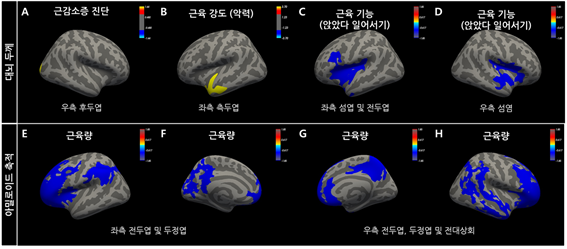근력 운동 꾸준하게 해서 건강도 잘 챙겨야겠어요 정보 감사드리고 즐건 주말보내세요
As muscle mass decreases, I keep experiencing 'flickering'... There was a reason for it (Who would have thought that muscle mass and dementia are related...)
I heard that in order to live healthily, I should start strength training after my 40s, but...
I didn't expect it to be related to dementia...
Really.. doing planks for even a few minutes and squats for more than five minutes..
I need to take care of it.. ㅠㅠ

Yeoido St. Mary's Hospital Catholic Brain Health Center Research Team
Im Hyun-guk, Yeouido St. Mary's Hospital Research Team
Analysis of the relationship between muscle mass and cognitive function
Domestic researchers have identified the cause of cognitive decline due to muscle loss for the first time in the world.
On the 28th, Professor Research Team of the Department of Psychiatry at the Catholic Brain Health Center, Yeouido St. Mary's Hospital, led by Im Hyun-guk, announced that they identified the mechanism by which sarcopenia causes cognitive decline through an analysis of 528 individuals without dementia, using sarcopenia scores and brain magnetic resonance imaging (MRI).
Sarcopenia is known to impair daily functions such as falls, fractures, and gait abnormalities, and to increase the risk of cognitive impairments such as Alzheimer's disease and vascular dementia. However, it has not been clarified how sarcopenia causes complex cerebral changes such as beta-amyloid accumulation in the brain, vascular changes, and cortical thinning.

Unlike the diagnosis of sarcopenia (A), the weaker the muscle strength, the more atrophy was observed in the left temporal lobe (B), and as muscle function declined, bilateral insular atrophy was more severe (C). The greater the muscle mass, the less amyloid accumulation was observed in the bilateral frontal and parietal lobes. Photo provided by Yeouido St. Mary's Hospital.
The research team analyzed the relationship between sarcopenia scores, which were based on muscle mass, muscle strength, and physical function, and brain MRI measurements such as cortical thickness, hippocampal volume, white matter degeneration, as well as brain amyloid deposition measured by amyloid-PET and cognitive function. As a result, muscle mass measured by bioimpedance devices, muscle strength measured by grip strength, and muscle function assessed by sit-to-stand tests all showed correlations with cognitive impairment. However, the causes by which each factor contributed to cognitive decline differed.
The less muscle mass there is, the more accumulation of beta-amyloid protein, a substance that causes Alzheimer's disease, was observed. The weaker the muscle strength, the thinner the temporal lobe cortex became, and as muscle function declined, the thickness of the bilateral insular lobes atrophied. The insular lobe is a region responsible for perceiving and interpreting internal and external body conditions.
High muscle mass has been shown to have an effect of suppressing beta-amyloid protein accumulation. High muscle strength prevented white matter degeneration, thereby protecting against brain atrophy and cognitive decline. Good muscle function directly demonstrated positive effects on protecting brain atrophy and cognitive function. Maintaining muscle quantity, strength, and function even in old age is important in preventing neurodegenerative changes and cognitive decline.
Professor Lim said, "Medical approaches to physical conditions related to sarcopenia could become new means and goals to reduce the risk of developing dementia." This study was supported by the Korea Creative Content Agency and the Catholic University Artificial Intelligence and Brain Science Project Group, and was published in the official journal of the International Alzheimer's Disease Association, 'Alzheimer's & Dementia.'